Four reasons we're overweight healthcare

Wilsons Advisory
Historically, healthcare has been an all-weather sector, with stocks that can compound earnings over the cycle. The pandemic reversed this trend for the ASX 200 healthcare sector. Since April 2020, the ASX 200 is up 49%; the healthcare sector is flat.
We think the next 12 months will be very different from the last, with vital signs improving for the sector.
We moved overweight the sector in August by adding ResMed (RMD).
We are overweight healthcare as:
- It offers defensive earnings to weather a slowdown.
- Earnings look to be at the start of an upgrade cycle (economic slowdown or not).
- Valuations look reasonable relative to pre-COVID – the sector could rerate on easing inflation.
- Healthcare offers a number of high-quality companies, with pricing power.
CY23 could continue to be challenging due to inflation, rate hikes and worries about a recession. Against this backdrop, we think healthcare stocks - which have historically been reliable defensives - can provide a degree of downside protection amidst volatile conditions.
As a result of the range of dynamic products and services now dominating the healthcare market, select stocks have the ability to withstand challenging economic environments while delivering long-term growth.
Over the next 12-24 months, stock selection will be key in the healthcare sector. We remain cautious about healthcare stocks that benefited from the pandemic; analyst earnings forecasts in these stocks look to be over-optimistic in a post-pandemic world.
Figure 1: ASX 200 healthcare has underperformed the broader market since April 2020; however, it has outperformed over the long run
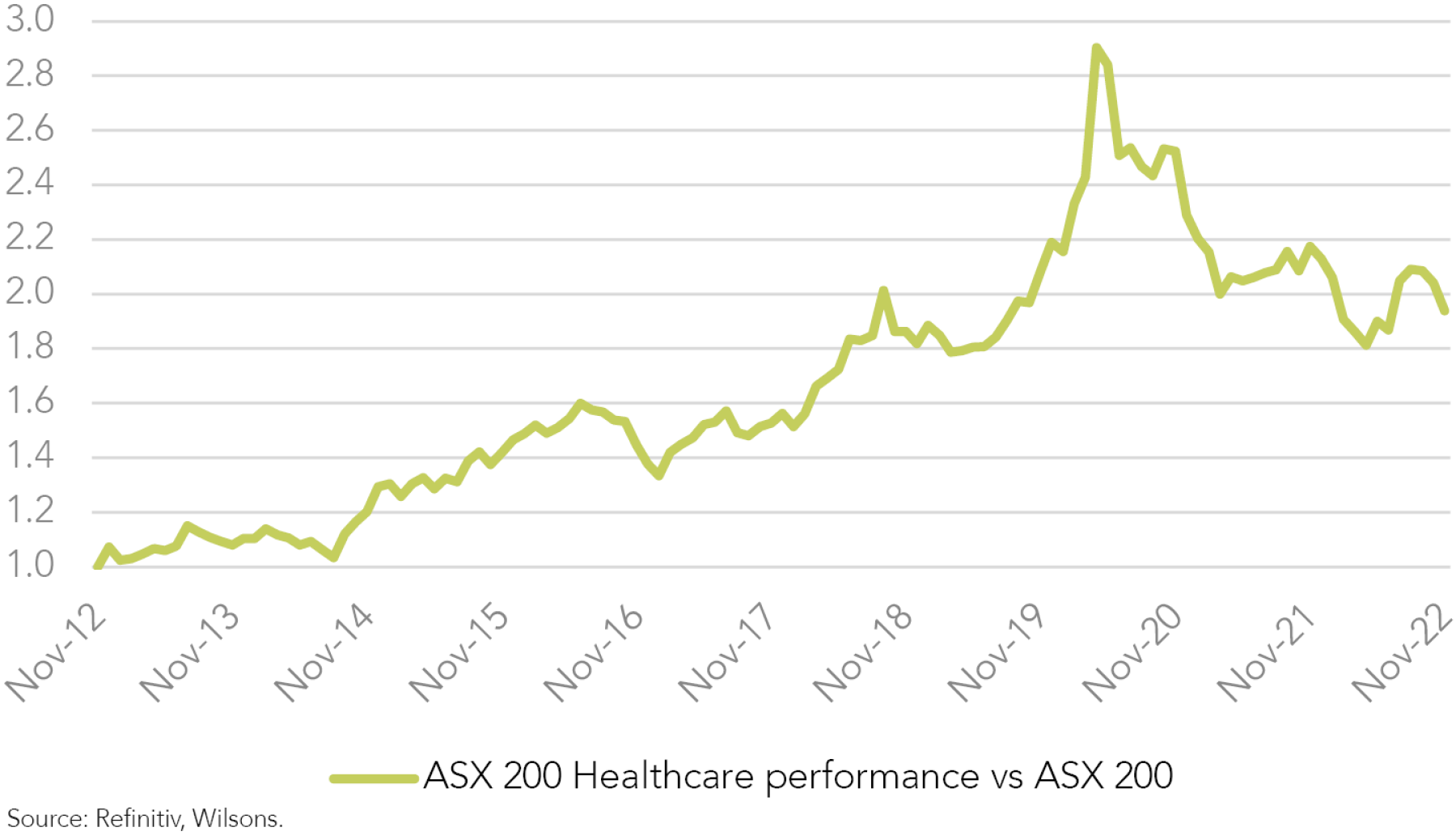
Earnings recuperating
Spending on healthcare actually fell in some countries during the pandemic. The battle against COVID-19 led to non-urgent care being cancelled and/or patients avoiding hospitals.
The pandemic also meant that healthcare product sales reps were unable to access hospitals as usual to conduct their sales activities.
However, after this pandemic-induced downgrade cycle, we believe we are at the beginning of an upgrade cycle for the healthcare sector. Like travel or leisure stocks, the market is still too pessimistic on the speed of the recovery. As this spending recovers, we should start to see earnings coming in ahead of consensus. This should be a tailwind for outperformance.
Figure 2: Healthcare earnings growth looks too low; we expect upgrades over the next 12 months
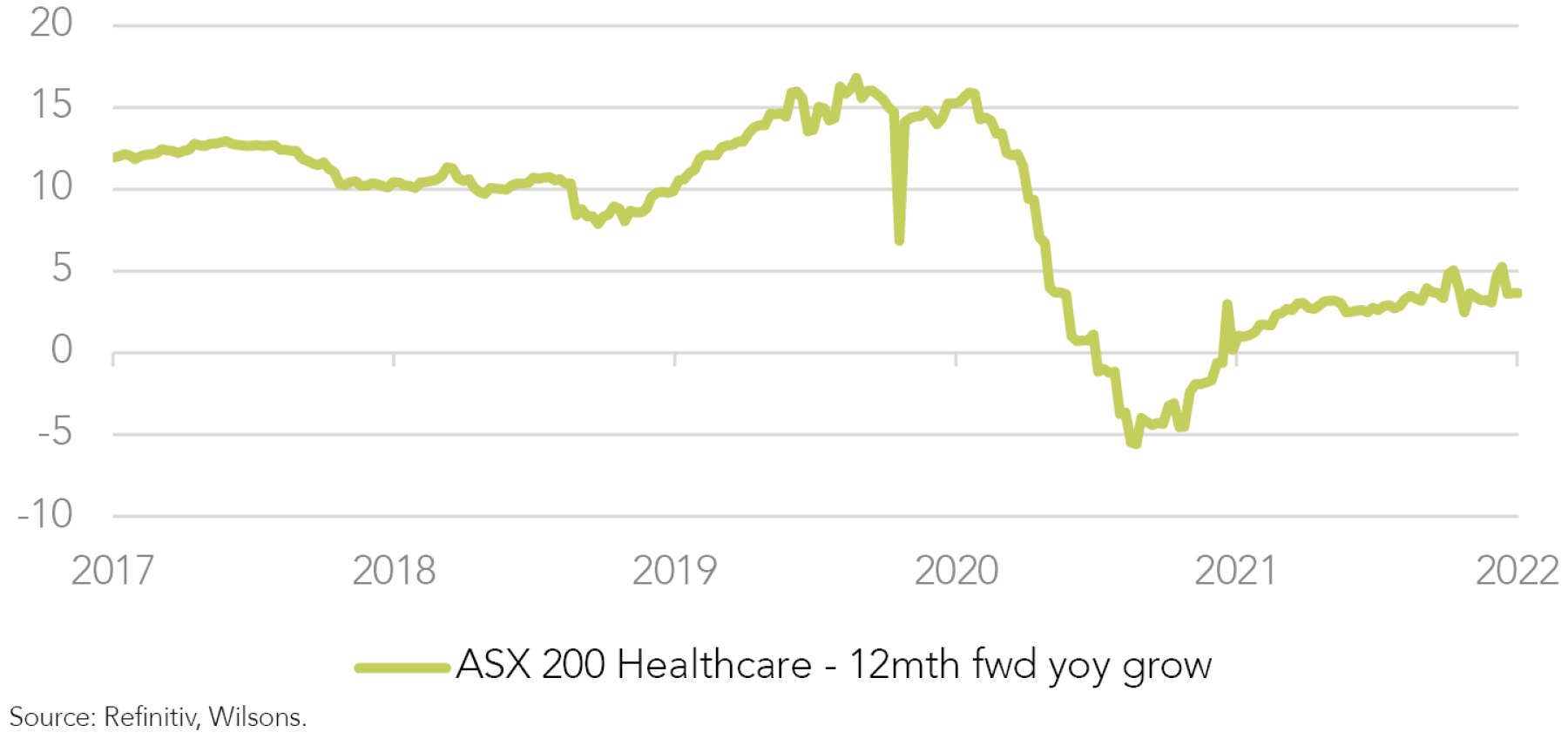
Dependable defensive sector
As a portfolio buffer when equity markets turn volatile, healthcare has long been considered one of the most reliable defensive sectors.
During the pandemic, this came under question.
However, ultimately this was an extraordinary set of circumstances, and we continue to believe that healthcare remains a defensive sector with a relatively inelastic demand profile. It is unlikely that households will cut back on healthcare expenditures relative to discretionary items, even in the face of a downturn. As a result of this robust demand profile, the sector can generate defensive earnings that enable it to outperform in weak macroeconomic environments.
Figure 3: Healthcare typically outperforms in weaker macro backdrops - relative average monthly performance vs ASX 300
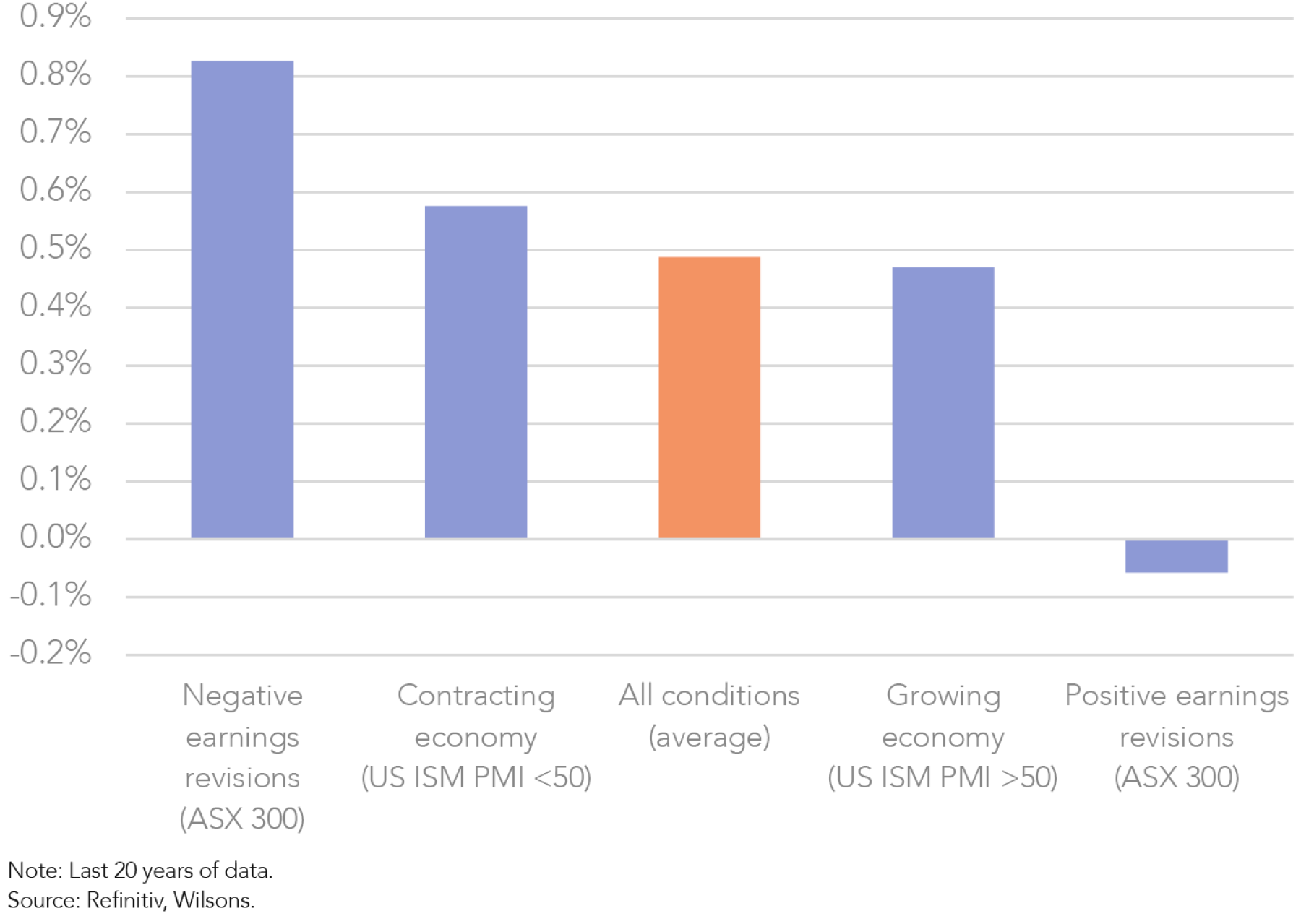
Structural growth over the cycle
Healthcare stocks have plenty of defensive characteristics that help them outperform in recessions and late in economic cycles. But they can also generate significant structural earnings growth over the cycle. This is one of the key reasons why the sector should outperform over the long-term.
If we look at earnings and performance before the pandemic, these stocks typically outperformed in slowdowns, but also perform well in most market conditions. The pandemic was really an anomaly in what is usually a strong performing sector.
Thus, we think the sector is relatively well placed irrespective of what direction the global economy takes over the next few years. This is unlike some other traditional defensive sectors (like utilities and consumer staples) which would likely underperform in stronger market conditions.
Figure 4: Healthcare earnings have grown faster than the market over the past 20 years
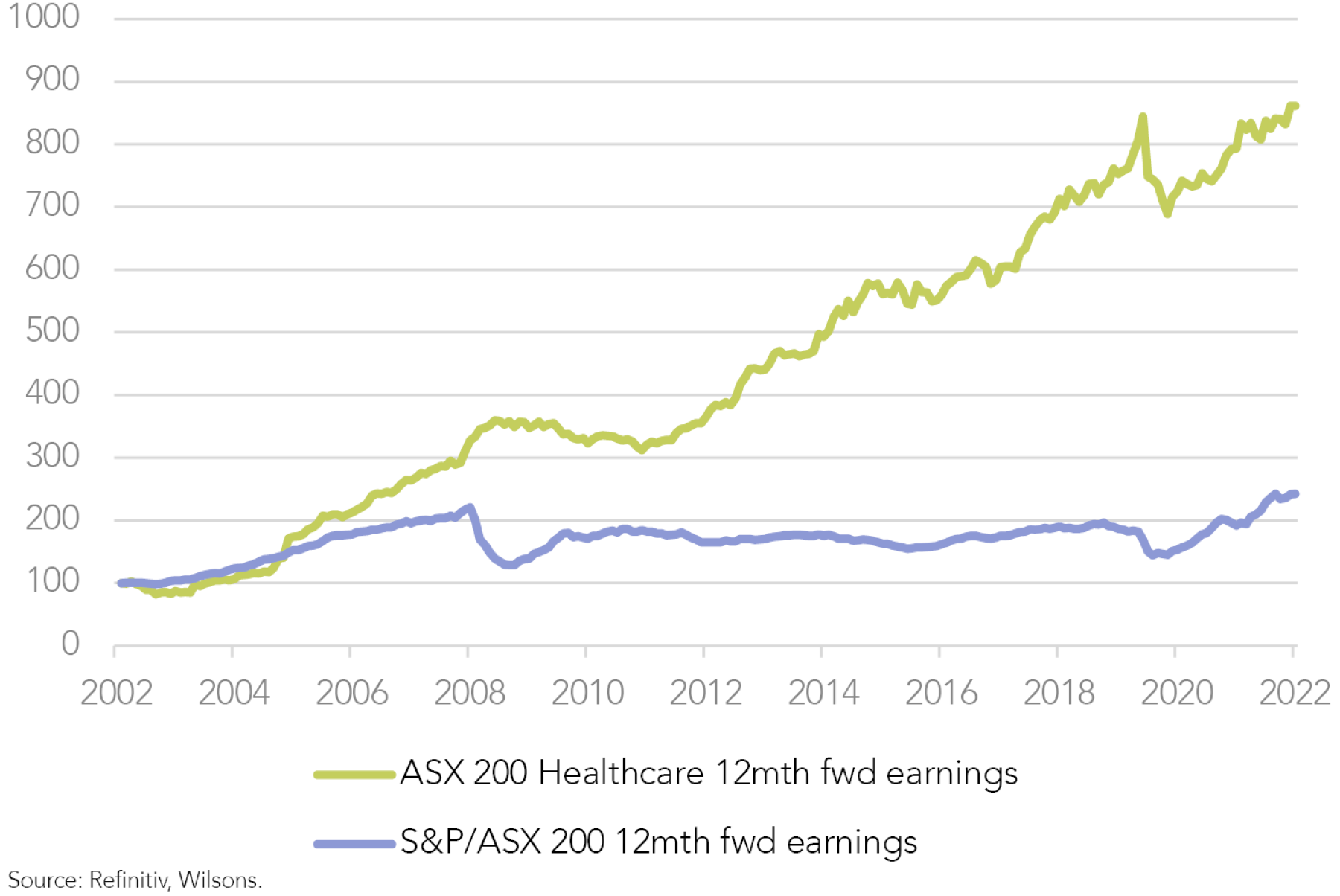
Valuation pain easing
Large caps in the healthcare sector are some of the most highly valued on the ASX. Since the beginning of the year, higher bond yields have put pressure on these valuations. Valuations now appear relatively inexpensive, especially in light of a global slowdown. Over the next 12 months, we believe healthcare could rerate as a safe haven asset.
Additionally, a sector which is generally considered to be growth-oriented could benefit if inflation fades, central banks pivot, and bond yields compress. Falling bond yields could be another opportunity for healthcare to rerate, which is a plausible scenario for next year.
Figure 5: Valuations look inexpensive, particularly with the backdrop of a global slowdown
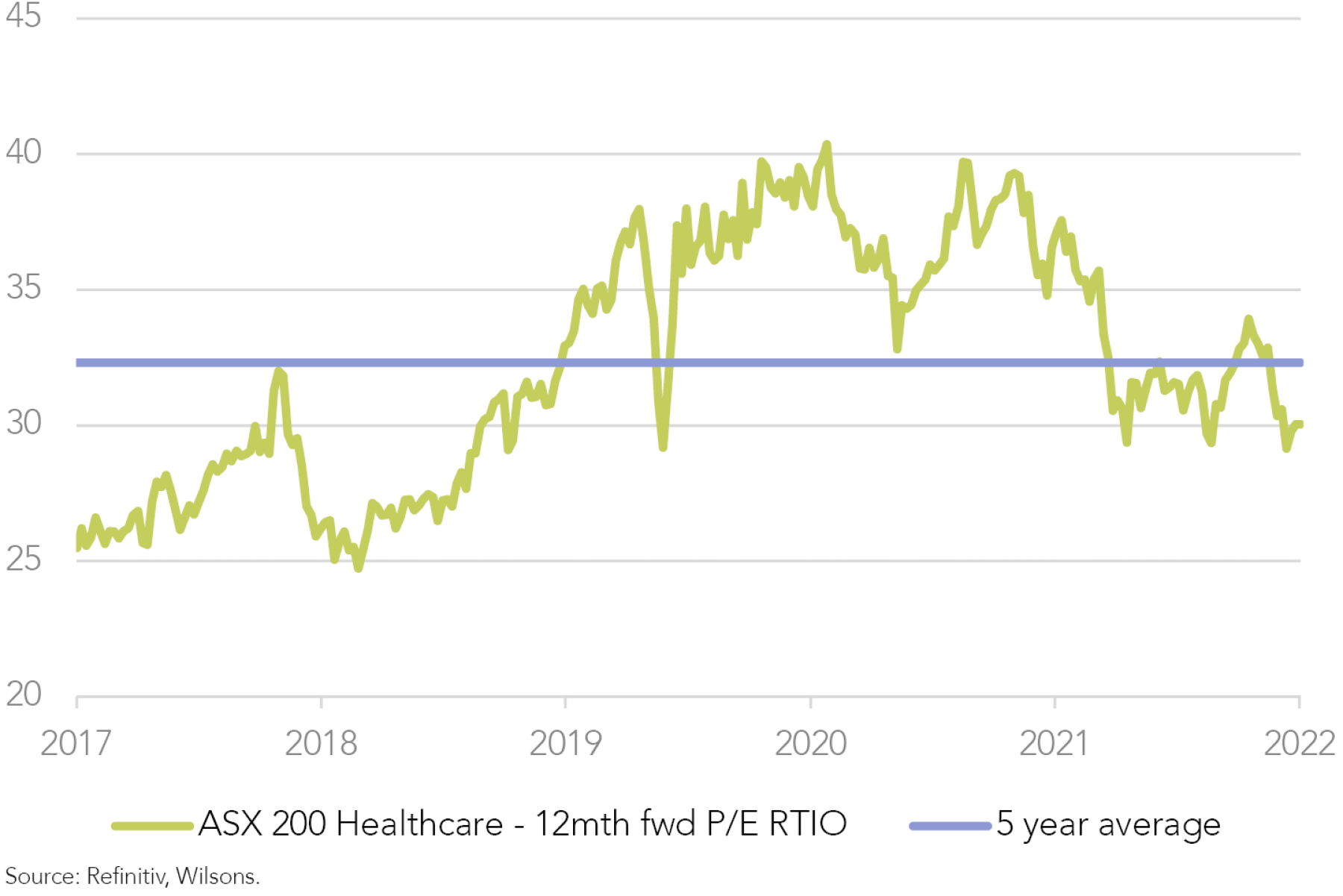
Quality with pricing power in an inflationary environment
Large-cap healthcare stocks on the ASX tend to be high-quality companies with pricing power. CSL (ASX: CSL), Resmed (ASX: RMD), and Cochlear (ASX: COH) have strong positions in the market. Consequently, if costs rise, they can be passed on to consumers, who are price takers. In an inflationary environment, this is very valuable. Cost pressures should not adversely impact these companies' earnings margins.
Stock selection critical
Some ASX 200 healthcare stocks experienced supernormal profits during the pandemic due to an increased demand for vaccination/testing centres, consumables (like masks) and respirators.
The challenge for healthcare analysts is forecasting earnings for these companies in a post-COVID world, and we believe this is fraught with risk – most likely downside risk.
We believe these earnings levels are unlikely to be sustainable into the future and these stocks face the risk of earnings downgrades.
Sonic Healthcare (ASX: SHL) is a case in point. Pre-COVID, the company saw a steady increase in EPS from 2017-2020, growing at ~1% per annum. Extrapolating this “normalised” growth to FY25E gives an EPS lower than consensus, at around $1.25. Consensus is forecasting an EPS of ~$1.63.
We believe this is too high and still accounts for the one-off COVID spending that is already fading. This leaves room for earnings downgrades over the next few financial years.
Figure 6: SHL’s consensus EPS looks too high; we think there could be downgrades to come
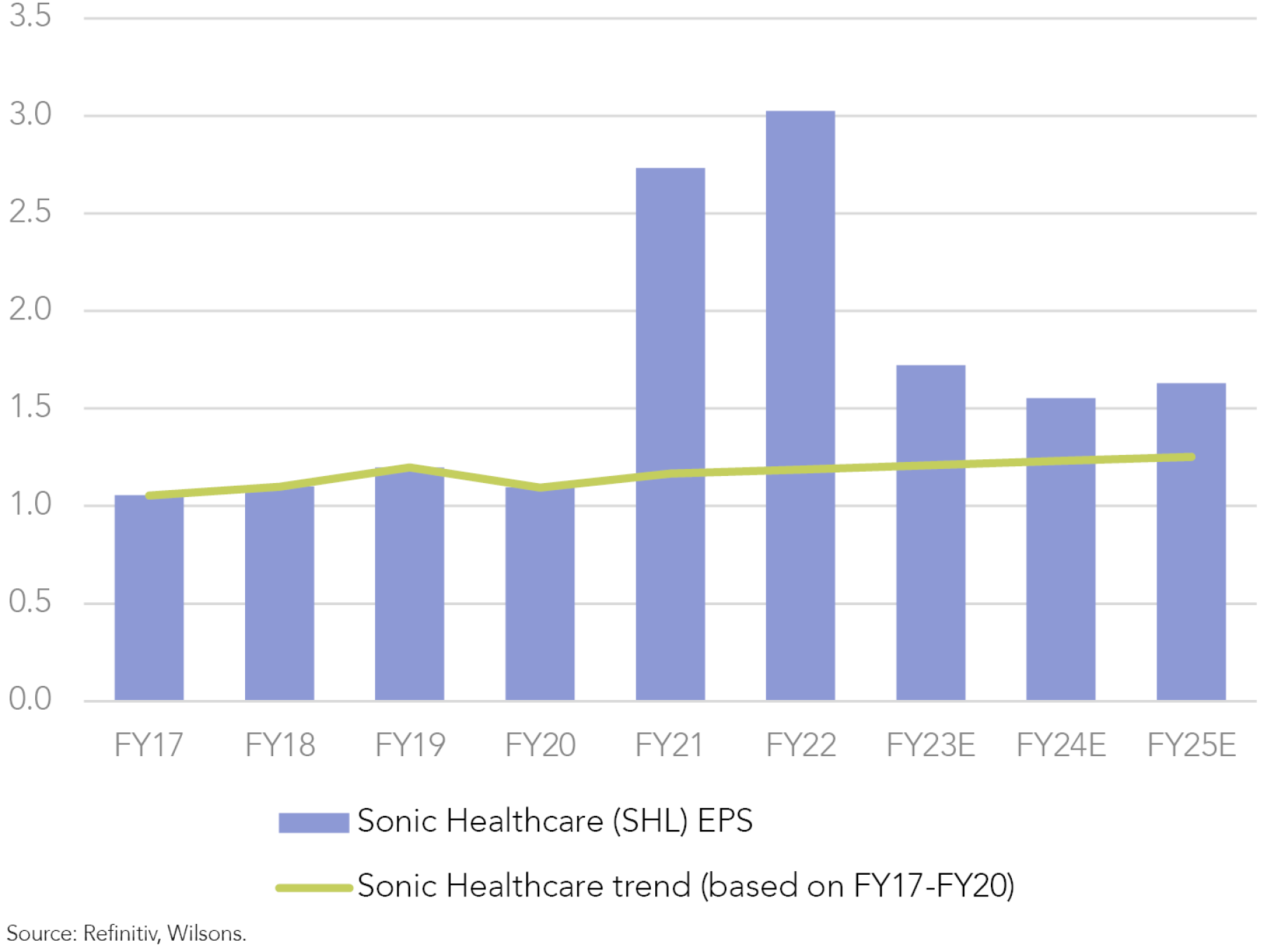
Healthcare stocks we like
ResMed (RMD): Gaining dominance
RMD develops, manufactures and sells continuous positive air pressure (CPAP) devices for the treatment of sleep disordered breathing. Its Respiratory Care franchise focuses on non-invasive ventilators, high-flow oxygen and mechanical ventilators to manage chronic obstructive pulmonary disease and associated breathing disorders like Obstructive Sleep Apnea (OSA). RMD is also a leading provider of software-as-a-service (SaaS) solutions for healthcare settings adjacent to hospitals.
Why we like RMD:
- Dominant market position: RMD is the dominant player within the CPAP market, which in our view reflects the superiority of its offering and a history of strong execution from management.
- Structural above-system growth: the global CPAP market remains significantly under-penetrated. This under-penetration drives typical organic ‘system growth' of 6-8% p.a., which is structurally above healthcare at 2-3% p.a.
- Market share opportunity: RMD’s major competitor, Phillips, first announced a recall of its CPAP devices in July 2021, which has presented a significant opportunity for RMD to take material and lasting market share. Recent feedback from RMD’s management following its Q123 result has been constructive. The business highlighted it has the capacity to supply the whole market if the opportunity presents.
- Valuation upside: If Philips cannot recover and becomes marginalized, we think RMD should be valued inline with other healthcare players on the ASX that dominate their respective markets, namely COH and Fisher & Paykel Healthcare ( FPH) which typically trade around ~30x EBITDA.
Figure 7: RMD should take more market share; this should be supportive of margin expansion
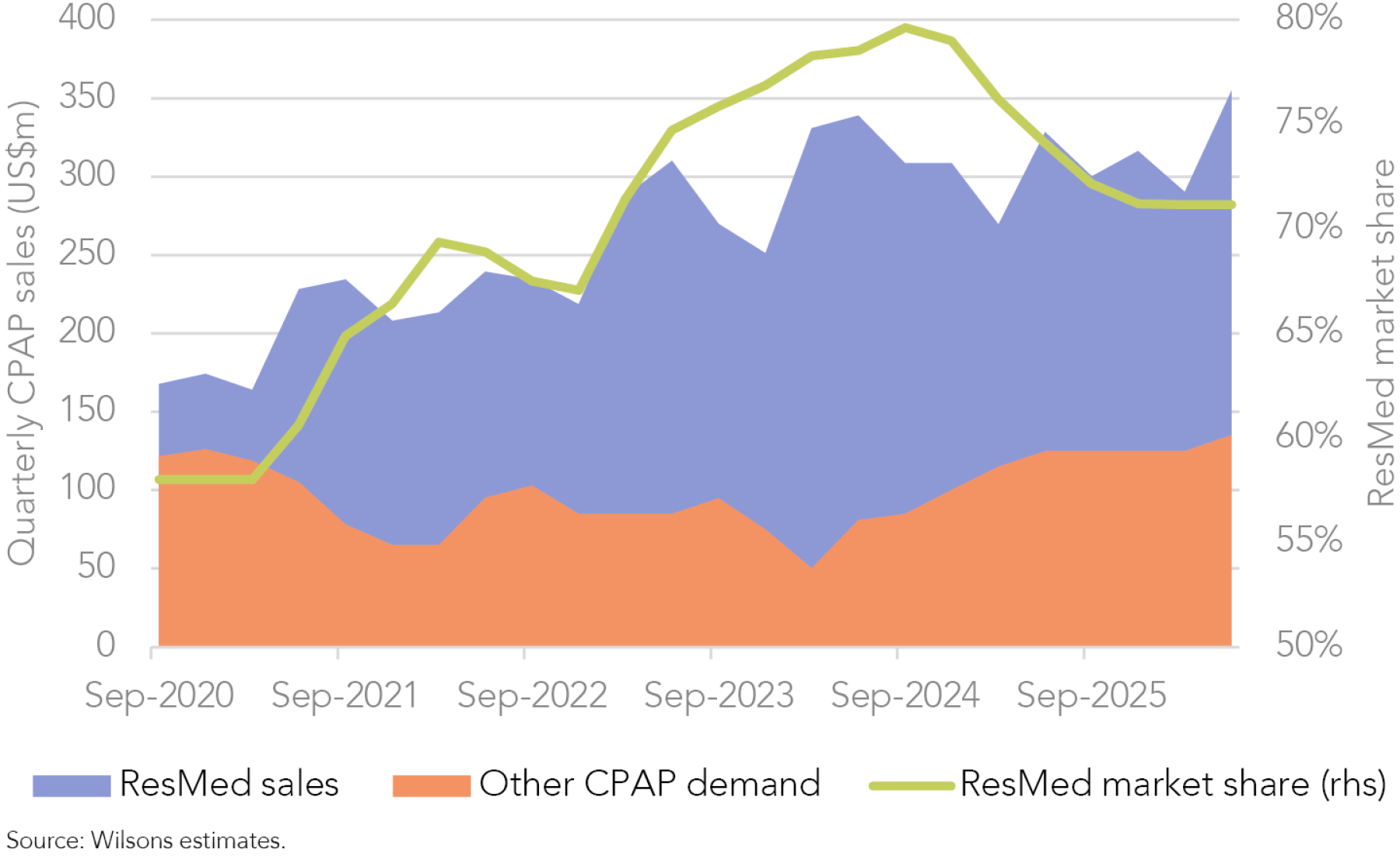
CSL (CSL): Plasma recovery
CSL is the dominant and lowest cost player within the global blood plasma industry. The business develops a range of biotherapies and vaccines that treat people with serious diseases and chronic medical conditions.
Why we like CSL
- Supply constrained market: The market for Immunoglobulin (IG) products is supply constrained, while underlying demand is highly defensive given IG is used to treat patients with a range of serious immunologic and neurologic diseases. Given this backdrop, there is confidence that there will be demand from end users even as supply increases.
- Plasma recovery: CSL was impacted by lower plasma collections during COVID-19. Without a key input, CSL's revenues and gross margins were adversely affected. Positively, collection volumes are recovering and now exceed pre-pandemic levels as fears of the virus have faded and stimulus cheques have dried up.
- Higher collection capacity: The business has also invested significantly into its IG Infrastructure, by expanding its collection centre network (opened +27 new centres in FY22 bringing the global total to 330) and by implementing new technologies. The new Rika Plasma Donation System will allow for the collection of more plasma in less time, increasing throughput by 30%. We expect CSL's larger collection network, in combination with higher donor numbers and operational efficiencies from new tech, to drive higher IG volumes and margins over the medium-term.
- Valuation: Our healthcare analysts have a target price of $318.33 per share for CSL based on a DCF valuation. CSL currently trades on a 12-month forward EV/EBITDA multiple of ~18x, which it views as attractive considering consensus forecasts point to an EBITDA CAGR of 19% over the next 3 years.
Figure 8: CSL's earnings growth is expected to be driven by both higher volumes and stronger margins
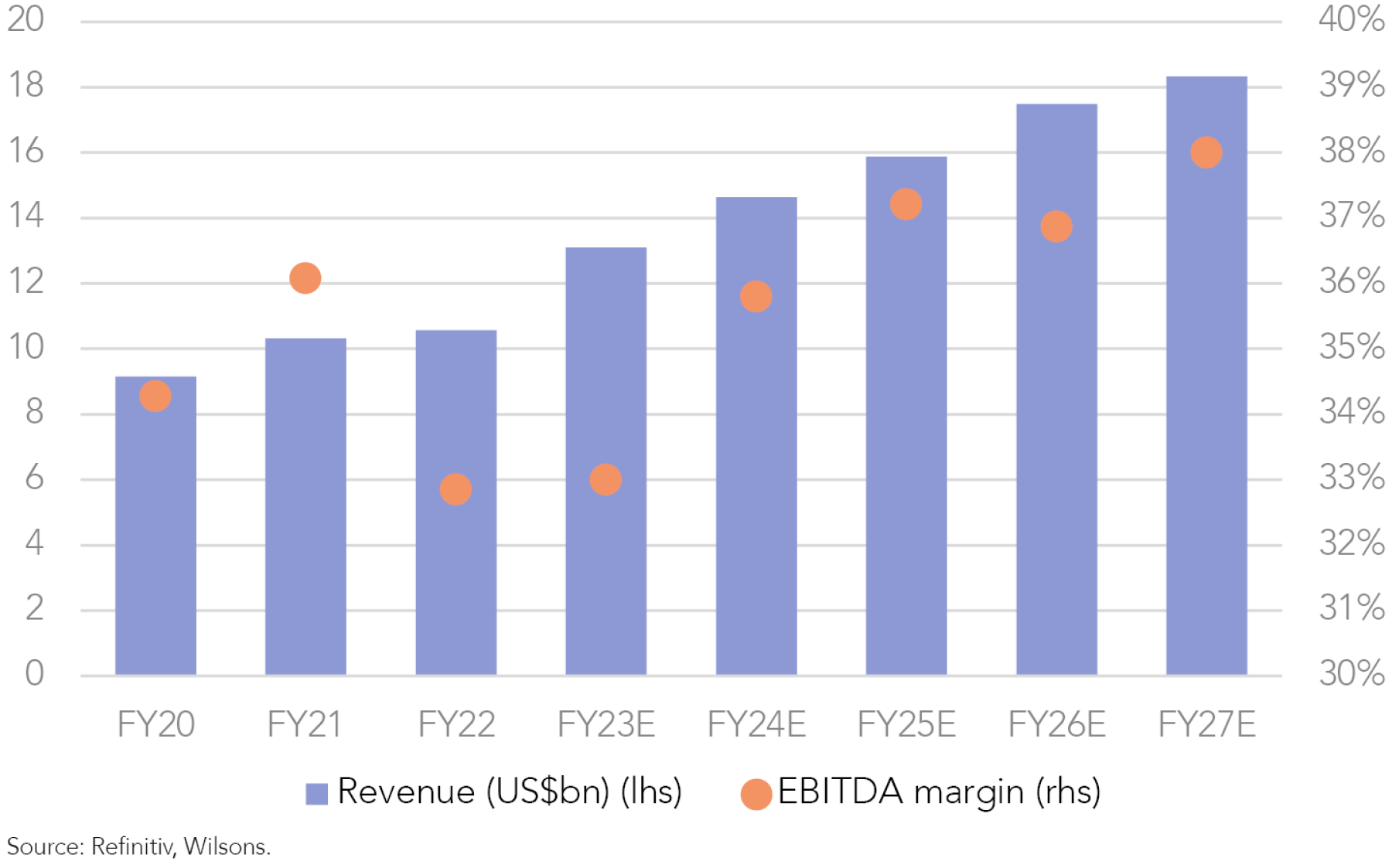
Telix Pharmaceuticals (TLX) - Pipeline of opportunities
TLX (ASX: TLX) was established to create a new industry leader in radiopharmaceuticals. Telix has programs focused on prostate, renal and brain cancer indications among others. In April 2022, Telix launched its first FDA approved product, ILLUCCIX, a diagnostic imaging agent for prostate cancer. With proof of product sales now demonstrated, Telix has moved out of the pre-revenue biotech space and into a commercial business with a capacity to meet, and potentially exceed revenue forecasts.
Why we like TLX
- Better diagnosis and treatment: Telix's pipeline of products is based on molecularly-targeted radiation (MTR) employing the use of radioisotopes attached to targeting agents, which specifically bind to cancer cells. Using this technology, numerous forms of cancer are able to be precisely imaged and treated, potentially offering better-informed treatment decisions and more personalised cancer therapy.
- Upside in the pipeline: The Phase III ZIRCON positive study results that were announced earlier this week support regulatory filings for TLX250-CDx as a PET/CT agent for kidney cancer diagnosis, with the trial meeting both primary and key secondary endpoints. Telix’s US development pathway could achieve FDA approval and launch by the end of 2023. If approved, Telix’s agent will be the first and only non-invasive means of identifying the most aggressive, and common, form of kidney cancer; clear cell renal cell carcinoma (ccRCC). If approved, TLX250-CDx looks likely to become the new standard of care, obviating tens of thousands of unnecessary kidney surgeries each year.
- Large addressable markets: The company's core prostate cancer imaging product, ILLUCIX, has an estimated Total Addressable Market (TAM) of US$1b. Our analysts estimate TLX can attain a 28% share of the PSMA-directed PET/CT market. After its first full quarter, ILLUCIX's early commercial performance in the US has exceeded market expectations. Meanwhile, the TLX250-CDx agent (Phase III trial) has an estimated TAM of US$500m in the US.
- Valuation upside: Valuing the TLX opportunity is an exercise in judging probabilities. Our analysts’ base case valuation is $8.15. However, we remind readers that the pathways for biotech approval and commercialisation are not always the one-way street of good news!
Figure 9: Telix core pipeline: Oncology and rare diseases, new products could be a key driver of earnings growth over the medium-term
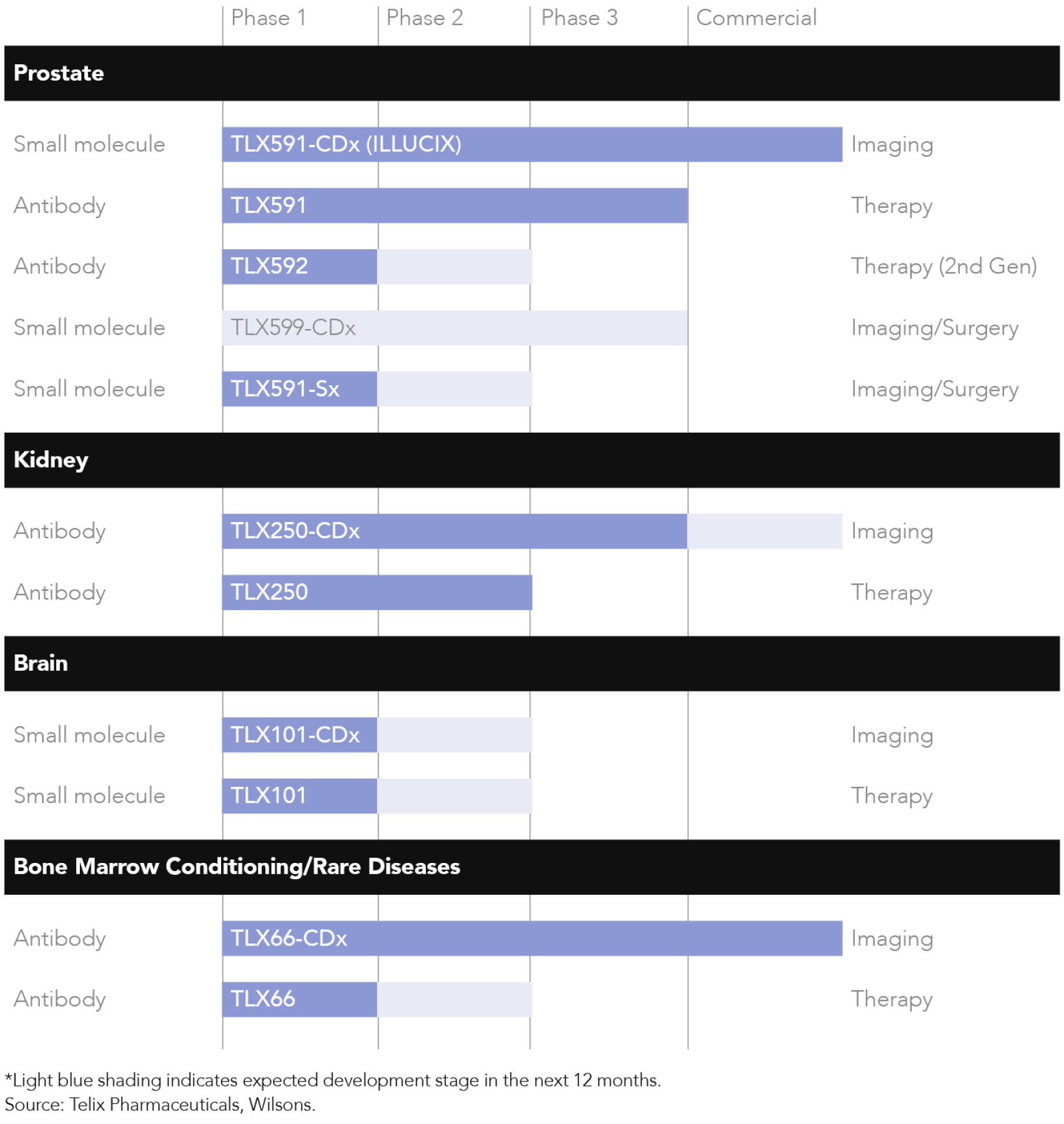
Want more insights like this?
WILSONS think differently and delve deeper to uncover a broad range of interesting investment opportunities for their clients. To read more of our latest research, visit our Research and Insights.
